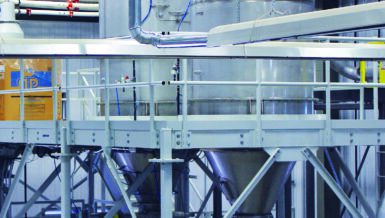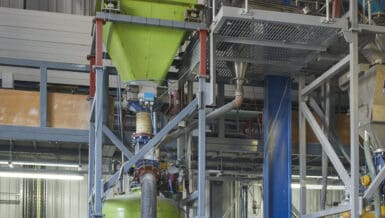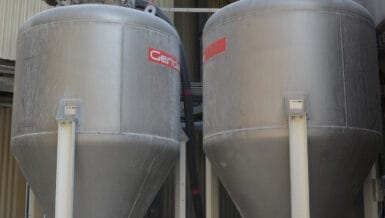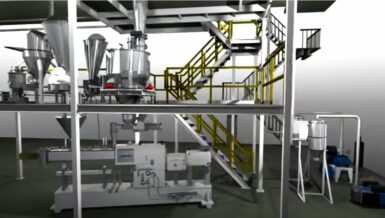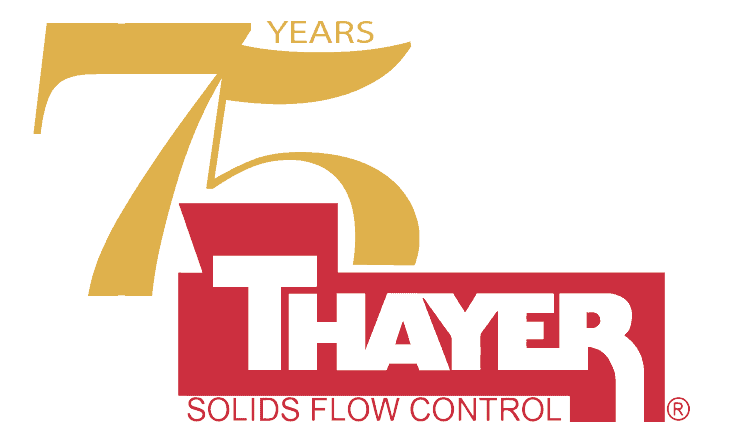This overview of the basics of dense-phase pneumatic conveying explains how dense-phase systems function, their benefits and drawbacks, and considerations for designing your own conveyor. With this information, you’ll be well-equipped to determine whether a dense-phase pneumatic conveying system is the right choice for your materials and operational goals.
What is dense phase pneumatic conveying?
Dense phase pneumatic conveying is a process for moving dry bulk materials through enclosed, airtight pipes from one silo to another using gas. The defining feature of a dense phase system is that it uses a small weight of air to move materials gently along the bottom of the pipe. This keeps material and component damage to a minimum.
Unlike dilute phase conveying, which constantly meters material into a high-velocity gas stream, the material in a dense phase conveyor flows in slugs. This means that the bulk density of the material when moving through the conveying line is very close to that of the material at rest. Inside the pipes, there are pockets of gas between the material slugs rather than a single continuous stream.
Types of dense phase pneumatic conveying
Dense phase pressure conveying
In a system that uses dense phase pressure conveying, the dry bulk material is first loaded into a pressure vessel. When the vessel is full, compressed air is used to move the material into the conveying line. Once the vessel and line are empty, the compressed air is switched off and the vessel is reloaded for the cycle to begin again.
Pressure conveying is most suitable for conveying fragile or abrasive materials with particles of ¾ inch or smaller.
Dense phase vacuum conveying
Manufacturers typically use dense-phase vacuum conveying to transfer granules and powders for truck or railcar unloading. This type of system features a pressure vessel with a fluidizing bottom. That means it can handle semi-abrasive and fluidizable powders that need aeration to discharge into the conveying line.
Dense phase vacuum conveying is well suited to moving semi-abrasive and fluidized materials. But it’s not a good choice if you convey fragile materials with large or variable particle sizes. This method should only be used for particles of ¼ inch or less.
What materials can a dense phase system convey?
Dense-phase pneumatic conveying is used across both light and heavy industries. It’s a popular choice for moving abrasive materials and can successfully convey agglomerated, friable, and blended bulk materials of all kinds.
Materials commonly processed using a dense phase pneumatic conveying system include:
- Alumina
- Candies
- Carbon black
- Cocoa beans
- Dextrose
- Feldspar
- Fly ash
- Glass batch mix
- Glass cullet
- Hazelnuts
- Puffed rice cereal
- Resins
- Silica sand
- Sorbitol
Benefits of dense phase pneumatic conveying
- Low material degradation: The air velocity in a dense phase system is typically as low as 3-8m/s at the beginning of the line. This allows for very gentle material transfer, which reduces wear, impact, breakage, and waste and increases the quality and salability of your product.
- Reduced component wear: Low material velocity also means your pneumatic conveying components endure less wear, particularly from abrasive materials. This lowers your maintenance expenses and decreases system downtime, meaning greater productivity and cost savings for your business.
- Protects against material segregation: Transporting mixed-batch materials at high density with low airspeed reduces the risk of segregation and downstream processing issues. This is why dense-phase pneumatic conveying is the method of choice for conveying powders after a mixer.
- High energy efficiency: If you succeed in reaching a high solids load ratio, the low gas requirements of dense phase conveying make this method highly energy efficient. This lets you keep operational costs to a minimum.
Drawbacks of dense phase pneumatic conveying
- Higher capital cost: Dense-phase pneumatic conveying systems typically require a higher initial investment than dilute-phase systems.
- Greater system dimensions: These systems tend to be bulkier than dilute phase systems. This can be a problem if your facility floor space is limited.
- Shorter conveying length: The higher pressure drop means dense phase systems generally offer a shorter conveying length compared to dilute-phase alternatives. This can be solved by increasing system pressure, but this can also increase costs.
3 considerations for your dense phase pneumatic conveying system
If you convey fragile, abrasive, or friable materials that can be conveyed at low gas velocity, a dense-phase pneumatic conveying system might be right for you. But before you start designing your system, here are three key factors you should take into account.
System design and calibration
When manufacturers design and run their dense phase pneumatic conveying system like a dilute phase system, they compromise their system’s efficiency and productivity.
Low-pressure dilute phase systems use an entry air pressure under 15 psig to move materials through the conveying line at a high velocity while suspended in the air stream. But high-pressure dense phase systems use smaller amounts of high-pressure air of 15-50 psig to move material through the line at a low velocity as slugs. Due to the low air-to-material ratio, dense-phase pneumatic conveying systems generally use narrower pipe diameters than dilute-phase systems.
Failing to adapt the air pressure to match your type of system could lead to an increase in product degradation and component wear.
Fluidization
Fluidization is the process of using motive gas to make materials flow like a liquid. Dense-phase pneumatic conveying systems typically rely on fluidization for bulk solids transportation.
However, not all materials will fluidize. Some fine granules, such as calcium carbonate, actually compact under pressure. This can create line plugs, leading to unexpected system downtime and increased maintenance costs.
The same is true for mixtures of fine and coarse powders of different shapes or irregular sizes. If the material segregates, the coarse particles will gather in the lines while the fine particles fill in the gaps to create a solid plug.
On the other hand, not all materials need to fluidize at all. Medium-size particles move efficiently without fluidization, provided the length and pressure of the system has been suitably calibrated.
Air injection
Depending on the length of your conveying line and the properties of your dry bulk material, your dense phase system might benefit from additional air injectors. As well as helping you maintain conveying velocity over longer distances while reducing line plugging, these extra air pulses minimize the bridging of fine powders in the transporter cone.
You might believe the additional cost of adding and running air injectors would compromise the savings afforded by energy-efficient dense phase conveying. But by ensuring a smoothly flowing system that doesn’t plug, you can make those investments back in reduced maintenance costs.
Achieve peak efficiency, productivity, and reliability with industry-leading parts
If you convey fragile, abrasive, or friable dry bulk materials, dense phase pressure or vacuum conveying could be an excellent fit for your facility. Dense phase systems offer energy-efficient conveying with minimal component and material wear, allowing you to maintain high product quality while keeping costs low.
But simply designing and installing a dense-phase pneumatic conveying system isn’t enough to optimize your performance and profitability. You also need to ensure your system is fitted with durable, cost-effective, abrasion-resistant parts that give you a strong competitive edge.
As veterans in the pneumatic conveying industry, we’ve had more than 40 years to perfect our inventory of high-performance components. Each elbow, fitting, and coupling we provide is designed to remain in your system for extended periods with minimal wear. That means you can rely on our industry-leading parts to keep your system at peak productivity for as long as possible.







